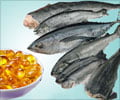Could intake of fish have a protective role on brain cancer development? Read the results of the meta-analysis to find out more.
Highlights
- Brain tumor affects nearly 14.4 per 100,000 persons on an annual basis.
- Polyunsaturated fatty acids (PUFAs) found in fish are reported to be essential for brain and intelligence development especially in children.
- Some studies have shown that fish intake was associated with lower risk of brain tumor.
The study focused on total fish intake, including fresh and frozen fish. Smoked, pickled and salted fish was not included in the study.
Study
- A meta-analysis with dose-response analysis was conducted to study the association between fish intake and brain cancer risk.
- PubMed and EMBASE electronic databases were reviewed and pertinent studies were identified.
- Nine observational studies (involving a total of 4428 brain cancer cases and 501,617 participants) were included in the meta-analysis.
- Amongst the nine observational studies, six studies were population-based case-control studies, two were hospital-based case-control studies and one was cohort study.
- The pooled relative risks (RR) were calculated using the fixed-effects model, provided there was no heterogeneity observed amongst the studies.
- Subgroup, meta-regression and publication bias analyses were also conducted.
- The pooled relative risk of brain cancer for the highest vs. lowest category of fish intake was reported to be 0.83, with no significant heterogeneity.
- Dose-response analysis revealed that the relative risk (RR) per 100 g/week increase in fish intake was 0.95.
- In the subgroup and sensitivity analyses, the results remained unchanged.
- Thus results of the dose-response analysis showed that fish intake might be associated with lower brain cancer risk.
- The study involved a large sample size of 501,617 participants which included 4428 brain cancer patients.
- The study was conducted over a long duration from 1986 to 2006.
- Dose-response analysis was conducted to quantify the association between fish intake and brain tumor risk.
- The meta-analysis involved mostly low-quality case-control studies which were subject to recall and selection bias.
- It involved only one prospective cohort study which showed null finding between fish intake and risk of brain tumor
- There was no adequate adjustment done for some factors which would potentially influence the stability of the results such as irradiation exposure, total energy intake, body mass index, amongst others.
- There was lot of heterogeneity found amongst the studies including characteristics of study population, sample size, follow-up duration and exposure levels of fish intake.
The meta-analysis results put forward the consideration that intake of fish could lead to lower risk of brain cancer, however the findings need to be substantiated in future with additional cohort studies with validated questionnaires as well as having a strict control over confounding variables.
Source-Medindia
















